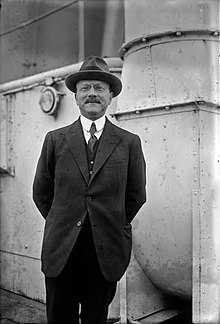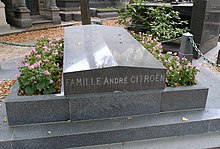André Citroën
André Citroën | |
|---|---|
 André Citroën on an ocean voyage | |
| Born | André-Gustave Citroën 5 February 1878 |
| Died | 3 July 1935 (aged 57) Paris, France |
| Nationality | French |
| Occupation(s) | Business, engineering |
| Known for | Founder of Citroën |
| Relatives | Alfred Lindon (brother in law) |



André-Gustave Citroën (French: [ɑ̃dʁe ɡystav sitʁɔɛn]; 5 February 1878 – 3 July 1935) was a French industrialist and the founder of French automaker Citroën. He is also remembered for his application of double helical gears.
Life and career
Born in Paris in 1878, André-Gustave Citroen was the fifth and last child of Jewish parents,
The Citroen family descended from a grandfather in the
His father died by suicide when André was six years old (presumably after failure in a business venture in a diamond mine in South Africa). It is reputed that the young André Citroën was inspired by the works of Jules Verne and had seen the construction of the Eiffel Tower for the World Exhibition, making him want to become an engineer.
Citroën was a graduate of the
Citroën bought the patent for very little money, leading to the invention that is credited to Citroën: double helical gears. Their distinctive pattern was reputed to be the inspiration for the double chevron marque of the Citroën brand. In 1908, he was installed as a chairman for the automotive company Mors, where he was very successful.[4]
During World War I, he was responsible for mass production of armaments. Citroën gained an international reputation during the war, and more as the leading production expert in France. His activities were extensive in connection with the Renault plant, which employed 35,000 men in the manufacture of munitions during the war.[citation needed]
In the middle of 1919, Citroën was one of the directors of the Société Française Doble, Paris, to build steam cars in France. Some other directors of the company were Paul Sicault, of the Renault Co.; M. Mery, of the Turcat-Mery Co.; M. Delage, the automobile designer.[citation needed] The design was not feasible and Citroën turned to other projects.
Citroën founded the
He died in Paris, France, of stomach cancer in 1935, and was interred in the Montparnasse Cemetery, the funeral being led by the Chief Rabbi of Paris.
Posthumous recognition
On 9 October 1958, while the Motor show was running, the city fathers renamed the Quai de Javel as the "Quai André-Citroën," in recognition of the transformation effected since the city's 15th arrondissement, two generations earlier characterized by market gardening, had been selected by Citroën as the location for Europe's first mass production car plant.[5]
This was the second celebrity name for the street which in 1843 had been baptised "Quai de Javel," in recognition of the chemical factory that had been set up to produce a range of industrial acids, and which later numbered the well known eponymous "Eau de Javel" (bleach) among its products.[5]
In 1992, the
See also
- Arthur Constantin Krebs, Panhard General Manager from 1897 to 1916
References
- ^ Reynolds (1997)
- ISBN 9781455613298.
- ^ "het geslacht citroen" (in Dutch). Retrieved 28 September 2023.
- ^ "Mors". Brighton-Early. Archived from the original on 9 December 2004.
- ^ a b "Automobilia". Toutes les voitures françaises 1959 (Salon Paris Oct 1958). 21. Paris: Histoire & collections: 27. 2002.
- ^ Pringle-Harris, Ann (2 November 1997). "The 15th, a World of Its Own". The New York Times. Retrieved 3 May 2008.
- ^ "André Citroën". Hall of Fame Inductees. Automotive Hall of Fame. 1998. Archived from the original on 16 March 2016. Retrieved 4 March 2016.
Bibliography
- Reynolds, John (1997). Andre Citroen: The Man and the Motor Cars. Basingstoke: Palgrave Macmillan. ISBN 978-031-216-505-5.
- Broustail, Joël (2020). Citroën et le citroënisme : essai historique sur la passion automobile et l'innovation [Citroën and Citroenism: Essay on the History of Automobile and Innovation] (in French). Paris: Au Pont 9. ISBN 9791096310609.
External links
- Insecula encyclopedia (in French)
- Citroënët
- Newspaper clippings about André Citroën in the 20th Century Press Archives of the ZBW
